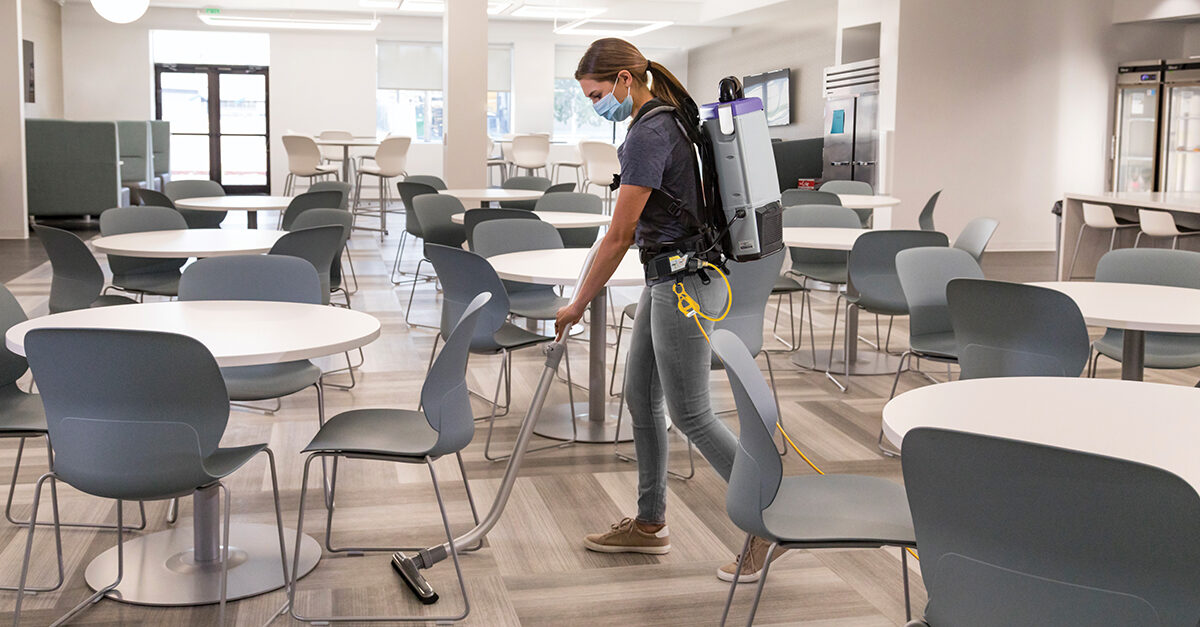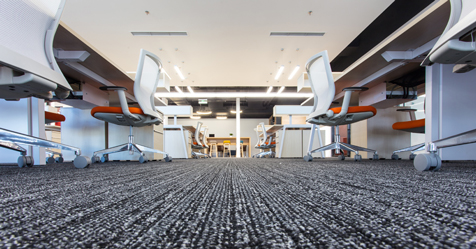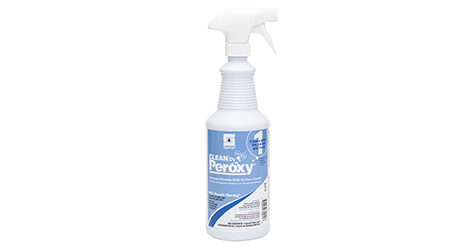From tight spaces and staircases to wide open areas, backpack vacuums have got your back.
These tools enable professional cleaning staff to clean around furniture, in cubicles, and on top of shelves, according to experts from TTI Floor Care—which owns Hoover, Oreck, and Dirt Devil—and ProTeam Inc., a business unit of Emerson Electric Co. With the right attachments, staff can clean high areas such as vents without taking their feet off the floor.
“In most buildings there are all kinds of different environments you will be cleaning, and a backpack vacuum is excellent for most areas,” said Rich Steinberg, vice president of sales for ProTeam. “They are also great for removing dust on hard surfaces in addition to carpets. Companies who refinish floors often use backpacks to clean and detail before applying floor finish.”
“Backpack vacuums are ideal for going up and down stairwells, as well as tackling any large public area,” said Eddie Bray, director of sales for TTI Floor Care. “They are preferred for spaces like large convention centers and spacious casino floors.”
Save time and labor
The most obvious benefit to backpack vacuums is their ability to save labor time by increasing your staff’s efficiency. It’s easier to maneuver a 14-inch tool on an aluminum wand that weighs about 11 to 13 ounces, compared to 15 to 22 pounds you’re pushing with an upright vacuum. “Whether you’re cleaning a small or a large area, backpacks are perfect as they can clean so much more square footage quicker and more efficient than an upright vacuum,” Steinberg said.
When you factor in cordless models, the efficiency is even greater. According to Bray, a corded backpack will allow a professional cleaner to vacuum about 12,000 to 15,000 square feet an hour. Switching to a battery model can enable your cleaning staff to vacuum up to 42,000 square feet an hour.
“That’s a huge jump in productivity when you don’t have to walk back to the outlet every 50 feet, unplug the unit, and walk to the next outlet,” he said.
Cordless backpack vacuums are often a safer option as well, as they can prevent slip, trip, and fall accidents. “It’s hard to find a consistent labor force, so when you do you want to keep them safe and healthy,” Bray said.
Get a good fit
Wearing a vacuum is a new experience for many people. A typical backpack weighs about 18 to 14 pounds for a battery-operated unit and about 12 to 10 pounds for a corded unit.
“Some of the most important things people are looking for in a backpack vacuum is comfort and ergonomics,” said Steinberg. He recommended looking for a model with a comfortable harness. “You want something that is cooling and comfortable, that distributes weight evenly and moves with you, not against you.”
Bray recommended models with a waist harness that will transfer the weight from your shoulders to your hips. “The key is wearing it correctly,” he said. “A lot of time we see people wearing it like a school backpack without the stomach strap, so their shoulders hurt after 20-30 minutes.” Steinberg agreed. “The strongest part of the human body is the muscles right below the hips, so that’s where you want to wear the vacuum, right above the hips, that’s where all the weight should be distributed,” he said.
Adjustability and good instructions are also key. “You can put the best harness on the best vacuum, but unless it is easy to adjust it and people understand how to put it on, it is all for naught,” Steinberg said. “The harness must be easy to adjust, because multiple people will be using it.”
Perfect your movement
Once you have the fit down pat, next you should work on your movement. “With a backpack vacuum you use a more side-to-side movement rather than forward and backward movement,” Bray said. “Because you are not trapped by wheels that just go forward and backward, and you are using a wand with a tool, you can go side to side, almost like a swivel action of your hips, to cover more area faster.”
“With the side-to-side motion, going at your walking pace, you’re able to get in and out of corners and under things,” said Steinberg. “You can hit a four- to five-foot area in one sweep, getting three to four times the coverage, rather than only 14 inches ahead of you accessible with an upright vacuum.”
Staff training is essential once you transition from upright to backpack vacuums. “If your workers are not properly trained, they will use a backpack the same way as an upright vacuum, and they will not get anywhere near the productivity they could with it, plus it will be hard on their bodies,” Steinberg said.
Breathe easier with filtration
Backpack vacuums offer HEPA media filters and other advanced filtration technologies to remove particles of varying sizes from facilities. “Not only are you using vacuums to clean what you can see, but also what you can’t see, which is often more harmful,” Steinberg said.
According to Steinberg, a good model will not only remove particles already in the building, but also those the vacuum emits, such as carbon expelled from the vacuum motor. “It’s important to capture the carbon as it exits,” he said. The motor pulls the dust and debris down into the disposable filter, and the HEPA media filters capture the motor carbon before it enters the environment.”
Steinberg said he has heard from long-time cleaners who, after switching to vacuums with better filtration, have left work feeling better than they have in years, without headaches or trouble breathing, symptoms they suffered with in the past from the dust disturbed after vacuuming. “Better equipment is better for building occupants and for the people using the equipment,” he said. “If you leave work feeling better, it’s because someone has cleaned better.”
When to go upright
Some tasks are still best left to upright vacuums, for instance, cleaning small areas like a hotel guest room. “You don’t want to take the backpack off every time you clean a bathroom then have to put it back on again for the next guest room,” explained Steinberg.
“Using it for a really compact area, like a 300- or 400-square foot room may be overkill,” said Bray, adding backpack vacuums are never recommended for cleaning areas that may be wet, like pool decks.
But all in all, backpack vacuums have the power and versatility to tackle most of your cleaning needs once you find one that offers the perfect fit and functions for your specifications.
Learn more vacuuming tips for your facility.




